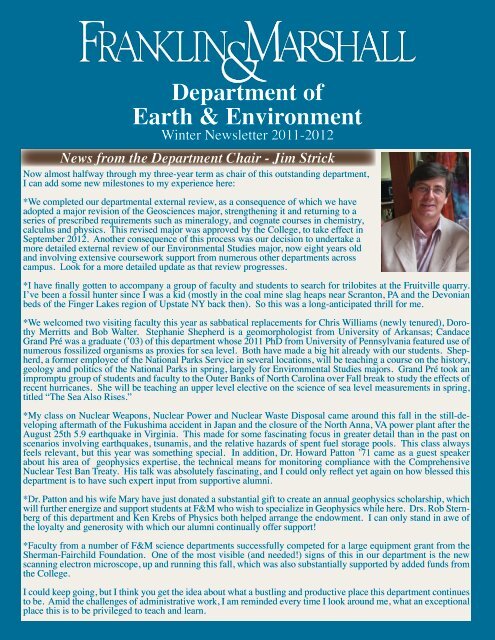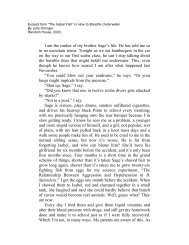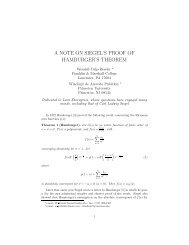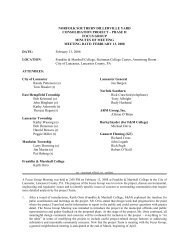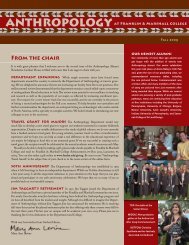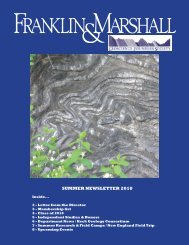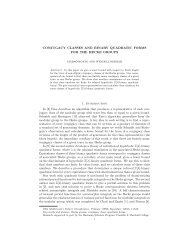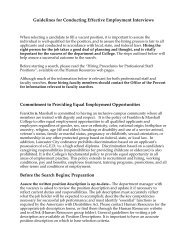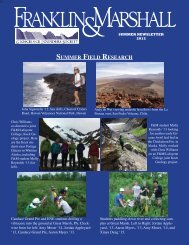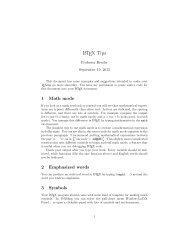Department of Earth & Environment - eDisk - Franklin & Marshall ...
Department of Earth & Environment - eDisk - Franklin & Marshall ...
Department of Earth & Environment - eDisk - Franklin & Marshall ...
- No tags were found...
You also want an ePaper? Increase the reach of your titles
YUMPU automatically turns print PDFs into web optimized ePapers that Google loves.
<strong>Department</strong> <strong>of</strong><strong>Earth</strong> & <strong>Environment</strong>Winter Newsletter 2011-2012News from the <strong>Department</strong> Chair - Jim StrickNow almost halfway through my three-year term as chair <strong>of</strong> this outstanding department,I can add some new milestones to my experience here:*We completed our departmental external review, as a consequence <strong>of</strong> which we haveadopted a major revision <strong>of</strong> the Geosciences major, strengthening it and returning to aseries <strong>of</strong> prescribed requirements such as mineralogy, and cognate courses in chemistry,calculus and physics. This revised major was approved by the College, to take effect inSeptember 2012. Another consequence <strong>of</strong> this process was our decision to undertake amore detailed external review <strong>of</strong> our <strong>Environment</strong>al Studies major, now eight years oldand involving extensive coursework support from numerous other departments acrosscampus. Look for a more detailed update as that review progresses.*I have finally gotten to accompany a group <strong>of</strong> faculty and students to search for trilobites at the Fruitville quarry.I’ve been a fossil hunter since I was a kid (mostly in the coal mine slag heaps near Scranton, PA and the Devonianbeds <strong>of</strong> the Finger Lakes region <strong>of</strong> Upstate NY back then). So this was a long-anticipated thrill for me.*We welcomed two visiting faculty this year as sabbatical replacements for Chris Williams (newly tenured), DorothyMerritts and Bob Walter. Stephanie Shepherd is a geomorphologist from University <strong>of</strong> Arkansas; CandaceGrand Pré was a graduate (’03) <strong>of</strong> this department whose 2011 PhD from University <strong>of</strong> Pennsylvania featured use <strong>of</strong>numerous fossilized organisms as proxies for sea level. Both have made a big hit already with our students. Shepherd,a former employee <strong>of</strong> the National Parks Service in several locations, will be teaching a course on the history,geology and politics <strong>of</strong> the National Parks in spring, largely for <strong>Environment</strong>al Studies majors. Grand Pré took animpromptu group <strong>of</strong> students and faculty to the Outer Banks <strong>of</strong> North Carolina over Fall break to study the effects <strong>of</strong>recent hurricanes. She will be teaching an upper level elective on the science <strong>of</strong> sea level measurements in spring,titled “The Sea Also Rises.”*My class on Nuclear Weapons, Nuclear Power and Nuclear Waste Disposal came around this fall in the still-developingaftermath <strong>of</strong> the Fukushima accident in Japan and the closure <strong>of</strong> the North Anna, VA power plant after theAugust 25th 5.9 earthquake in Virginia. This made for some fascinating focus in greater detail than in the past onscenarios involving earthquakes, tsunamis, and the relative hazards <strong>of</strong> spent fuel storage pools. This class alwaysfeels relevant, but this year was something special. In addition, Dr. Howard Patton ’71 came as a guest speakerabout his area <strong>of</strong> geophysics expertise, the technical means for monitoring compliance with the ComprehensiveNuclear Test Ban Treaty. His talk was absolutely fascinating, and I could only reflect yet again on how blessed thisdepartment is to have such expert input from supportive alumni.*Dr. Patton and his wife Mary have just donated a substantial gift to create an annual geophysics scholarship, whichwill further energize and support students at F&M who wish to specialize in Geophysics while here. Drs. Rob Sternberg<strong>of</strong> this department and Ken Krebs <strong>of</strong> Physics both helped arrange the endowment. I can only stand in awe <strong>of</strong>the loyalty and generosity with which our alumni continually <strong>of</strong>fer support!*Faculty from a number <strong>of</strong> F&M science departments successfully competed for a large equipment grant from theSherman-Fairchild Foundation. One <strong>of</strong> the most visible (and needed!) signs <strong>of</strong> this in our department is the newscanning electron microscope, up and running this fall, which was also substantially supported by added funds fromthe College.I could keep going, but I think you get the idea about what a bustling and productive place this department continuesto be. Amid the challenges <strong>of</strong> administrative work, I am reminded every time I look around me, what an exceptionalplace this is to be privileged to teach and learn.
Page 2 <strong>Department</strong> <strong>of</strong> <strong>Earth</strong> & <strong>Environment</strong> December 2011Faculty News UpdatesTim Bechtel (visiting scholar and adjunct)Hard to believe another year has flown by. I am still delighted to be at F&M. Felicia hassuccessfully steered the Geophysics business through a terrible economy, Ellen has declareda Geology major at Wellesley, Marian wants to join her there next year and major in Physics.(Put those two words together and what do you get ☺?) Maddie is doing mostly musicat Hempfield High School. Research on identification <strong>of</strong> plastic antipersonnel landminescontinues (we have trained a neural network to recognize them on holographic radar images),and our continued expeditions to work out the hydrogeology <strong>of</strong> a portion <strong>of</strong> the MammothCave system have raised more questions than they answered. Switzerland was purelyfor fun. (photo) That is Dan Bechtel F&M ’54 on the right.Sarah DawsonThe Wohlsen Center has had another exciting year. We’ve gotten to host a series <strong>of</strong> amazingvisiting speakers, and helped to bring an environmental workshop series to campus forthe local community. Students in my “Tooth and Claw” course wrote an illustrated book <strong>of</strong>beautiful fairy tales in which predators were the heroes, instead <strong>of</strong> the villains. One hundredkindergarten and first graders came to F&M to hear the stories and meet the actual animals,provided by ZooAmerica! It was a memorable day for us all. My own research students areresearching the behavior <strong>of</strong> honeybees and our local red-trailed hawks. We hope to start upa coyote research program in the coming year.Andy de WetLast summer Andy directed a Keck NSF-REU funded project with Jake Bleacher ‘00(NASA-GSFC) and Brent Garry (Smithsonian) on the origins <strong>of</strong> sinuous and braided channelson Mars. Four students including Julia Signorella (F&M ‘12) spent four weeks at F&M,NASA Goddard Space Flight Center, and Hawaii mapping channels on Ascraeus Mons andcomparing these features to volcanic features on Hawaii. The results <strong>of</strong> this work will bepresented at the annual LPSC in Houston and the Keck Research Symposium at AmherstCollege in 2012.Carol de WetI am still serving as Associate Dean and one <strong>of</strong> my responsibilities is working with new faculty,helping them meet our standard for excellence in teaching, and keeping their researchand scholarship on track throughout the academic year. I have also been involved in theannual Central Pennsylvania Consortium (CPC) (F&M, Dickinson & Gettysburg colleges)workshop for new faculty, as well as two CPC conferences for department chairs, and mostrecently, a CPC workshop on shared faculty governance. I am delighted to announce the success<strong>of</strong> a multi-disciplinary proposal to the Sherman Fairchild Foundation for $500,000.00 tosupport environmental science, broadly defined. This includes research and teaching in geoscience,climate change science, ecology, physics, and chemistry. The grant has allowed usto purchase a new Scanning Electron Microscope and other pieces <strong>of</strong> equipment and instrumentationthat will be used by multiple natural science departments at F&M. My researchon tufas and travertines from Tanzania and Chile is providing interesting information onPlio-Pleistocene climate conditions, and a major paper on the Cambrian Ledger Formationin York Co., PA, will be coming out in an American Assoc. <strong>of</strong> Petroleum Geologists specialvolume in 2012. For those <strong>of</strong> you who remember the little de Wet kids around the departmentin the 1990’s, Greg is now a graduate student <strong>of</strong> Ray Bradley’s at UMass, Emily is anAnthropology major at Wheaton College (Mass.) and Cameron is a junior in high school. Ilove hearing about what you all are doing so please keep sending me your news updates forthe newsletter!Candace Grand Pré ‘03 (visiting)Pr<strong>of</strong>essor Grand Pré graduated from F&M in 2003 (Geology & Astronomy) and went on toreceive her Ph.D. in <strong>Earth</strong> & <strong>Environment</strong>al Science from The University <strong>of</strong> Pennsylvaniain 2009. Her thesis was titled: The application <strong>of</strong> micr<strong>of</strong>ossils to reconstruct paleoenvironmentson passive and active margins: An examination <strong>of</strong> great earthquakes, hurricanes andrelative sea-level change, under advisor Dr. Benjamin P. Horton. Other research resulted inco-authorship <strong>of</strong> Late Holocene barrier island collapse: Outer Banks, North Carolina, USA(2007) in “The Sedimentary Record” (5: 4-8). She has also been co-principal investigator atthe EARTHWATCH SCAP project: Is sea level rising? from 2007 to the present.
Page 4 <strong>Department</strong> <strong>of</strong> <strong>Earth</strong> & <strong>Environment</strong> December 2011Faculty News UpdatesRich PepinoDuring the past year, I have continued to work as a member <strong>of</strong> the Lancaster County LeadCoalition. Our most recent report indicates that Childhood Lead (Pb) Poisoning in Lancastercontinues to be a public health concern for local children ages 0-6. Katherine Datin‘11 developed a Geographic Information System (GIS) presentation on a portion <strong>of</strong> thedata, and presented her findings to the Coalition at their spring meeting. I am going to be<strong>of</strong>fering a community-based course this spring that will focus on the childhood diseases<strong>of</strong> Asthma and Lead Poisoning. I am optimistic that our students will benefit from thecourse while raising an increased awareness to these public health risks in Lancaster.Suzanna Richter (adjunct)Suzanna has transitioned into her new roles as Prefect <strong>of</strong> the New College House and anAssociate Dean <strong>of</strong> Students. She has remained an active member <strong>of</strong> the college’s sustainabilityefforts and has enjoyed teaching “The <strong>Environment</strong> and Human Values” as a firstyearwriting seminar this Fall. Students in her course are testing strategies to decrease theconsumption <strong>of</strong> electricity, water, and paper towels on campus and to maximize recyclingin the 5 College Houses. This past summer, she taught 23 members <strong>of</strong> the Knowledgeis Power Program (KIPP) an abridged version <strong>of</strong> “<strong>Earth</strong>, <strong>Environment</strong>, and Humanity,”which included building solar stoves and visiting the Pioneer Coal Tunnel in Ashland, PA.Stephanie Shepherd (visiting)Pr<strong>of</strong>essor Shepherd received her Ph.D. in the <strong>Environment</strong>al Dynamics Program atUniversity <strong>of</strong> Arkansas in 2010. Her dissertation, The effects <strong>of</strong> land use on the fluvialmorphology <strong>of</strong> headwater streams in the Illinois River watershed, Northwest Arkansas,was completed under advisors Ralph K. Davis and John C. Dixon. Other research hasresulted in publications: Stream response to repeated coseismic folding, Tiptonville dome,New Madrid seismic zone (Geomorphology, Vol. 43, pp. 313-349); and Are streams onthe Springfield Plateau underfit? Applying Dury’s model to the Illinois River Watershed(Physical Geography, currently in review).Rob SternbergRob Sternberg continues his duties as faculty don <strong>of</strong> Bonchek College House. He iscurrently teaching fifteen Bonchek students in <strong>Earth</strong>, <strong>Environment</strong>, and Humanity as afirst-year seminar; all received iPads as part <strong>of</strong> a College program on mobile computingin the classroom. In the summer <strong>of</strong> 2011, he presented a poster on an archaeomagneticdata set at the General Assembly <strong>of</strong> the International Union <strong>of</strong> Geodesy and Geophysicsin Melbourne, Australia. Despite the excitement surrounding the Tohoku earthquake/tsunamiand the magnitude 6 earthquake in Virginia, Rob remains rather skeptical about thedemise <strong>of</strong> the <strong>Earth</strong> in 2012.Cheryl Stoltzfus-ShenkCheryl continues working as a Research Assistant for Dorothy Merritts and Bob Walteron their legacy sediments projects. As a pr<strong>of</strong>essional photographer, Cheryl has beenphoto-documenting Bob and Dorothy’s field work and locating sites <strong>of</strong> historic landscapephotos. Cheryl has three young sons and a not-so-young husband, who keep her movingat a fast pace outside the lab.Jim StrickJim is a historian <strong>of</strong> biology and medicine specializing in history <strong>of</strong> origin <strong>of</strong> life studies,has completed the research for his new book project, and is looking for some time amiddepartment chair duties to get the writing <strong>of</strong> the book underway in earnest. The book willdetail a series <strong>of</strong> origin <strong>of</strong> life experiments in Oslo, Norway in the late 1930s, their placein contemporary trends in biology and medicine, and the controversy that surrounded theexperiments. The scientist was Freudian- trained psychoanalyst Wilhelm Reich, who firstwent into the physiology laboratory trying to substantiate Freud’s libido theory. Reichwas also one <strong>of</strong> many biologists in the 1930s applying the Marxist philosophy <strong>of</strong> dialectical-materialismto work in the life sciences. Strick worked extensively in Reich’s archivesat the Countway Library <strong>of</strong> Medicine at Harvard, where he presented on this researchin November. He has a contract for this book from Harvard University Press. Jim alsoremarried this year and is working on consoldating a new, larger family.
Page 6 <strong>Department</strong> <strong>of</strong> <strong>Earth</strong> & <strong>Environment</strong> December 2011<strong>Department</strong>al Awards<strong>Environment</strong>al Studies Award - Sara N. Lupolt ‘11<strong>Environment</strong>al Science Award - Jennifer C. Everhart ‘11Geology Award - Ian J. Hagmann ‘11 & Laura N. Kratz ‘11Richard A. Shepherd ‘56 Award (formerly Alboum Prize) - Emily L. Wilson ‘11Nancy Juerges Geomorphology Award - Katherine M. Datin ‘11Lloyd S. Yeakel Memorial Award - Kristin D. Taddei ‘11Enviroscan Geophysics Award - Stephanie T. Douglas ‘12Wise-Beutner Structural Award - Patrick M. Maloney ‘11David T. Black Memorial Scholarship - Elvis Andino ‘12I thought it might be interesting to share a short story about two geoscience majors who are now ingraduate school, and let you know how your contributions to the Geoscience Founders Society helpedthem get there.In 2006, two young men arrived at F&M and ended up in a freshman seminar about water quality andthe Chesapeake Bay watershed. They became good friends and by their sophomore year were ready todeclare a major. They both decided on geoscience and began going on every field excursion the department<strong>of</strong>fered. They would spend part <strong>of</strong> their weekends collecting fossils or minerals in the region. Bythe summer between their junior and senior year they both started a field-based research project withDorothy Merritts and Bob Walter. They needed funds to keep the work going during their senior year astheir independent study research projects and were awarded the $500.00 Geoscience Founders SocietyStudent Research Grant. Each student who receives funding gives a short presentation on their work atthe Founders Society’s Annual Meeting during Homecoming each fall. These two young men used themoney to pay for their field and laboratory expenses, and ended up contributing in significant ways toDorothy and Bob’s legacy sediment project.Neither one came to F&M thinking that they would end up as geologists, but both found areas withinthe discipline that resonated intellectually with them. Doing independent research was a pivotal point forthem, as it so <strong>of</strong>ten is for our students. It took these fellows a couple <strong>of</strong> years to settle down and reallyconcentrate on their studies, but their enthusiasm and doggedness impressed the faculty, and receivingthe Research Grant was an important milestone for them. It was a clear demonstration that they werevalued by the department and that the faculty saw in them the potential to become excellent geologists.Both went on to graduate school and are now finishing their Master’s <strong>of</strong> Science degrees. Both have appliedfor admission to Ph.D. programs.This is just one example <strong>of</strong> the difference your contribution to the Geoscience Founders Society canmake. Over 160 <strong>of</strong> your fellow alumni have joined with a contribution <strong>of</strong> $25.00 or more. Please help enrichthe academic program at F&M, maintaining the level <strong>of</strong> excellence we expect from this department,by contributing whatever you can.Carol B. de Wet, Director, Geoscience Founders Society
December 2011 <strong>Department</strong> <strong>of</strong> <strong>Earth</strong> & <strong>Environment</strong> Page 7Alumni NewsMelissa Lane ‘87 spent eight weeks in Antarctica last yearto search for rocks from space for the National Science Foundation<strong>of</strong> NASA, as part <strong>of</strong> a project called ANSMET (ANtarcticSearch for METeorites). Read a full article about her exploits- “A ‘Beaker’s’ Trip to Antarctica: Living on the Ice, CollectingMeteorites” - in the Spring 2011 edition <strong>of</strong> the Planetary ScienceInstitute newletter: http://www.psi.edu/webfm_send/176Photo courtesy <strong>of</strong> PSIRachel Devoretsky ‘05 completed a M.Sc. degree at the University <strong>of</strong> Kansas working on Mioceneagedsediment gravity flow deposits in the Agua Amarga Basin, SE Spain. Combining the superb outcropexposures with petrography and petrophysical measurements, Rachel developed a predictive reservoir-analogmodel for the basin. She is now working for Chevron Energy in Houston as a member <strong>of</strong> the CarbonateStratigraphy Team.Caitlin Lippincott ‘06 plans to get married next year to “a wonderful man”. Ben proposed to her onthe Mid Atlantic ridge in Iceland (“smart guy”), a geologist’s dream! She is living in the Cambridge/Bostonarea and recently changed jobs, now working for a small start-up company called C12 Energy, tryingto break into the Carbon Sequestration business.Philip Dinterman ‘98Alden Dinterman arrived on August 21st at 12:14pm. He was 8lb 6ozand 21 inches long. All are doing well and being bolstered by visitsby grandparents! We hope that everyone gets to meet the little guysoon. Emmett is becoming somewhat more interested in him as eachday goes by.Kristen Taddei ‘11 is a Water Quality Research Analyst at The Cadmus Group in Washington DCMichael Juarbe ‘10 (ENV/GOV) is currently attending law school in his home territory <strong>of</strong> PuertoRico. Before that, he spent the first half <strong>of</strong> this year working for congressman David Wu (D - Oregon) asa legislative aide. He got to work on a substantial range <strong>of</strong> issues, but focused on environmental issues,Native American issues, and issues stemming from the House Science & Technology Committee. He alsogot first hand exposure to Small Modular Nuclear Reactors and how the nuclear industry is pushing hardto get funding and less red tape.Erin Carlson Loy ‘01 and Justin Loy also added a new memberto their family this year. Ryan Justin Loy was born Monday, March28th at 5:11 pm. He weighed 8 lbs and 6 oz and was 20 inches long.Welcome, Ryan, and congratulations to all!Kirk Silver ‘10 is attending University <strong>of</strong> Rhode Island’s Master <strong>of</strong> <strong>Environment</strong>al Science and Managementprogram, concentrating in Wetlands, Watersheds, and Ecosystem Science. He was impressed with URI’sconnections and has found that every class he takes there has been <strong>of</strong> interest.
Page 8 <strong>Department</strong> <strong>of</strong> <strong>Earth</strong> & <strong>Environment</strong> December 2011Alumni NewsJim Burnell ‘74 was featured in the Denver Post, (Jan. 2011) for his work on Rare <strong>Earth</strong> elements andtheir importance to Colorado, and the national economy, because <strong>of</strong> their use in renewable energy productsand processes.Megan Murphy Bishop ‘00 and James Bishop welcomed a new additionto their family this year. Isaac Murphy Bishop entered the world on November7th, weighing in at 8 lb. 10 oz. and 19 3/4 inches long. Welcome and Congratulations!Megan works at Chevron Energy Technology Co. in Houston.Jesse Yoburn ‘02 and his wife Tewlyn are overjoyed to introduce to you CaylaJames Yoburn, born at 7:33pm on 3/3/11 at St Luke’s hospital in Houston, TX! She was6 pounds, 10 oz (3.02kg), and 19.5 inches long. Congratulations and welcome, Cayla!Harrison T. Southworth ‘68 died unexpectedly at his home in New Hampshire on December 20, 2010. Hewas 63. Harry ran Garland Mill Timberframes, a multi-generational family business, with his brother Tom.Owen P. Bricker, III ‘58 died on March 23, 2011 at the age <strong>of</strong> 73. After graduating from F&M, Dr. Brickerwent on to earn an MS at Lehigh University and a PhD from Harvard. He worked most <strong>of</strong> his career at theUSGS and was an emeritus scientist at the time <strong>of</strong> his death. He previously taught geology at Johns HopkinsUniversity and was one <strong>of</strong> the designers <strong>of</strong> what is now the Chesapeake Bay Program. His research on theimpacts <strong>of</strong> acid rain played an important role in the establishment <strong>of</strong> emissions controls.George Silk ‘60 died in June 2011.ObituariesRichard M. Hallmark ‘73 (MS) died June 17, 2011. He was a longtime resident <strong>of</strong> Kenia, Alaska, where heworked worked as a junior high school science teacher from 1968-1990. After retiring from public educaitonhe worked for Fish & Game until 1993.WANTED: Mineral & Rock Samples!Over the past decade or more the department budget has been static. The net result is that replacement <strong>of</strong> rockand mineral specimens used extensively in the introductory Dynamic <strong>Earth</strong> course and to some extent in themineralogy – petrology course sequence has been pretty thin. If some <strong>of</strong> you avid collectors out there have some“excess” samples you might be willing to part with, the department could put them to good use. Many studentswill clearly benefit from your generosity. With regard to minerals we could use the more basic minerals, becausethat is where the attrition is the highest. For example: good fresh examples <strong>of</strong> pyrite, galena, chalcopyrite,pentlandite, pyrrhotite, pegmatite minerals, various garnets, tourmaline, and epidote are in very short supply. Inparticular, our collection <strong>of</strong> various metamorphic rocks could use some help, too. Let me know via email (stan.mertzman@fandm.edu) or give me a call (717-291-3818) if you are in a position to help the department out.Thank you.
December 2011 <strong>Department</strong> <strong>of</strong> <strong>Earth</strong> & <strong>Environment</strong> Page 9Research HighlightsElvis Andino ‘12 / Jordan Appleyard ‘13 / Peter Rippberger ‘12A Controlled Freeze-Thaw Experiment to Model Erosion <strong>of</strong> Stream Bank SedimentsRecent studies by F&M students and faculty suggest that needle ice formation along streambanks is a primary process by which sediment is eroded to surface waters. The purpose <strong>of</strong> thisstudy was to construct a laboratory experiment to identify the physical parameters under whichneedle ice forms, and to quantify the amount <strong>of</strong> sediment eroded due to freeezing and thawingprocesses. We used time-lapse photography and in situ soil moisture and temperature sensorsto derive the conditions necessary for needle ice growth. We measured the mass <strong>of</strong> sedimentlost upon thawing, and calculated the volume per area <strong>of</strong> sediment eroded by this process.JordanOur laboratory apparatus created a freezing front analogous to that observed in stream bankAppleyardsediments during the winter. Using data from six freeze-thaw cycles, we extrapolate our results to show that bankerosion by freeze-thaw processes can account for the entire suspended sediment load on the watershed studied.This project made possible by funding from F&M’s Committee on Grants.Project Adviser: Bob WalterPeter Rippberger ‘12 / Elvis Andino ‘12 / Jordan Appleyard ‘13Nutrient Release from Stream Bank Sediments: The Effects <strong>of</strong>Physical and Chemical Weathering <strong>of</strong> Stream Bank Sedimentson Nutrient SolubilityThe objective <strong>of</strong> this research was to recreate needle ice formation in stream banks using an experimental apparatusdesigned and built by our research group during the summer <strong>of</strong> 2011. The purpose <strong>of</strong> this study was tomeasure nitrate (NO 3) and orthophosphate (PO 4) mobility between soil and pore water (needle ice) before andafter multiple freeze-thaw cycles. Previous research suggested relatively high concentrations <strong>of</strong> nitrates in theneedle ice in the natural environment (Zhao 2010). Our results indicate that needle ice mobilizes phosphorus aswell, as the concentration <strong>of</strong> P lost from the soil after a freeze-thaw cycle closely correlates with that gained inthe needle ice. We hypothesize that freeze-thaw processes weaken orthophosphate bonds on particle surfacesmaking it available for pore water uptake. This work shows that freeze-thaw processes during the winter searsoncould be an important source <strong>of</strong> soluble nutrients to surface water in the region.This project made possible by funding from F&M’s Hackman Summer Scholars Program.Project Adviser: Bob WalterEvan Anway ‘13Calcium Carbonate Concretions in the Sedimentary Record and theirPaleoclimatic SignificanceLarge deposits <strong>of</strong> calcium carbonate concretions occur along the base <strong>of</strong>stream banks along Little Conestoga Creek, PA. Concretions are uncommonin streams, and typically occur in association with lake margins. The primarygoals <strong>of</strong> this project were to determine how and when these concretionsformed, and to reconstruct the environment in which they formed. Theseconcretions likely formed from algal deposits on quartz cobbles. Shell andnut samples collected from the stratagraphic column both above and belowthe concretion layer were dated in order to determine the time <strong>of</strong> concretionformation. Freshwater gastropod shells and paleo-seeds were collected from the column as well in order to reconstructthe ecology <strong>of</strong> the area before and after the concretions formed.This project was made possible by funding from the Mellon Scholars Program.Project Adviser: Rob Sternberg
Page 10 <strong>Department</strong> <strong>of</strong> <strong>Earth</strong> & <strong>Environment</strong> December 2011Jameson Jolles ‘12Research HighlightsBig Spring Run Archaeology: History <strong>of</strong> the Watershed duringthe HoloceneThe aim <strong>of</strong> this project was to examine two collections <strong>of</strong> Native Americanartifacts gathered from the Big Spring Run watershed in Lancaster, PA. Thefocus <strong>of</strong> this research was on prehistoric material culture, in hopes <strong>of</strong> establishingand supporting ongoing research concerning the prehistory and ecology <strong>of</strong>the watershed during the Holocene epoch. The artifacts were from surface collections, so no stratigraphic controlis available. Artifacts were identified using archaeological literature, and from discussions with experts on EasternWoodlands archaeology. Analysis <strong>of</strong> these artifacts suggests that habitation in Big Spring Rn dates from 8500years B.P. to the time <strong>of</strong> contact with European settlers ca. 250 years B.P. The presence <strong>of</strong> axe heads and millingstones suggests domestic activities dependent on trees. As well, local and non-local lithic materials indicatetrade networks. Diverse projectile point types imply various indigenous groups occupied the area surroundingBig Spring Run.This project made possible by funding from Pr<strong>of</strong>. Walter’s grant from the Pennsylvania <strong>Department</strong> <strong>of</strong> <strong>Environment</strong>alProtection.Project Advisers: Bob Walter and Dorothy MerrittsJory Chapin Lerback ‘13Does Leaf Mass per Unit Area Explain Insect-Plant Interaction inDeep Time?Previous studies <strong>of</strong> the Chickaloon Formation <strong>of</strong> Alaska indicate lush plantgrowth under warm temperate conditions ca. 55 Mya. Fossil leaf herbivoryis rare in the Chickaloon assemblage. About 9% <strong>of</strong> previously gathered leafspecimens show plant-insect interaction. This is lower than expected considering the higher damage frequenciesin other Eocene assemblages under similar paleotemperatures. In modern forests, leaf herbivory is negativelycorrelated with leaf mass per unit area (LMA). I tested the hypothesis that low leaf herbivory in the Chickaloonmight be explained by fossil plant LMAs. Estimated LMAs range from 31.52 to 130.14, with an average value<strong>of</strong> 63.64 ± 3.07 (n=44). My values are comparable to LMAs <strong>of</strong> other Eocene floras with high incidence <strong>of</strong> herbivory.Thus, fossil LMA does not explain the low leaf herbivory in the Chickaloon, suggesting some other factormay be a key determinant <strong>of</strong> fossil leaf herbivory in this paleoecosystem.This project made possible by funding from F&M’s Hackman Summer Scholars Program.Project Adviser: Chris WilliamsAmy Moser ‘14Analyses <strong>of</strong> Fossil Seeds Extracted from Pre-settlement HoloceneWetland Soils, Big Spring Run, PAPrevious macr<strong>of</strong>ossil seed analysis by F&M students and faculty revealedthat a resilient wetland ecology persisited in valley bottoms throughout theMid-Atlantic regions for ca. 10,000 years before European settlement.Subsequent construction <strong>of</strong> milldams and millponds buried these wetland environments, completely altering thevalley bottom hydrology. This study examined seeds extracted from ten buried wetland (hydric) soil sites in theBig Spring Run watershed in order to document spatial and temporal variations <strong>of</strong> pre-settlement wetland plants.Seeds, extracted from the top, middle and bottom <strong>of</strong> the ca. 30-cm thick hydric soil were photographed and identified.Our results show that the same species <strong>of</strong> wetland plants persisted acrosss space and time throughout theBig Spring Run valley, confirming that a stable wet meadow environment will help guide valley bottom wetlandrestoration practices at Big Spring Run and elsewhere in the region.This project made possible by funding from Pr<strong>of</strong>. Walter’s grant from the Pennsylvania <strong>Department</strong> <strong>of</strong> <strong>Environment</strong>alProtection and F&M’s Dept. <strong>of</strong> <strong>Earth</strong> & <strong>Environment</strong>.Project Advisers: Bob Walter and Doroth Merritts
December 2011 <strong>Department</strong> <strong>of</strong> <strong>Earth</strong> & <strong>Environment</strong> Page 11Research HighlightsConor Neal ‘12Measuring the Abundance <strong>of</strong> Micro-Boring Organisms in Coral andAssociated Volume Loss along a Depth Gradient and Over Time inSt. John, Virgin IslandsPhotosynthetic organisms living within coral tissue allow for more calcification wherelight intensity is greatest. Hence, it has commonly been assumed that reef accretionmust be greatest at the shallowest depths. This assumption has been challenged byrecent studies showing that the factors controlling production also control destruction.The interplay between the two factors causes total coral accretion to be almost equal along the depth gradient. The objective<strong>of</strong> this study is to quantify the bioerosion resulting from the action <strong>of</strong> micro-borers in samples from dead corals takenat known depths and times <strong>of</strong> death. Serial cross sections <strong>of</strong> impregnated coral will be examined, using a scanning electronmicroscope. This analysis will focus on the top centimeter <strong>of</strong> each sample, where micro-boring is most intensive. Microboringoccurs most extensively in the first year after coral death. We also intend to assess the state <strong>of</strong> preservation <strong>of</strong> theseborings later, after intense macro-boring has occurred.This project made possible by funding from the Keck Geology Consortium Research Program and the National ScienceFoundation.Project Adviser: Roger ThomasJulia Signorella ‘12Features on Mars: Fluvial vs. VolcanicDeciphering the water history is important to understanding the geological evolution <strong>of</strong>the planet and whether it could have sustained life. The research involves studyingchannel features on the flanks <strong>of</strong> the Ascraeus volcano, which is a part <strong>of</strong> the Tharsisprovince. Channel features on Mars, such as the features in Kasei Valles, are evidencefor water flowing over the surface in the past; however, not all channels are the product<strong>of</strong> fluvial processes and can be interpreted as volcanic. To determine which process formed these features, the rift apronarea is mapped in ArcGIS and the features are studied. Characteristics observed in Kasei Valles will also be used for comparisonto determine if the features are fluvial. They are then compared to analogous Hawaiian lava flows to determine ifthe features are volcanic.This project made possible by funding from the KEck Geology Consortium.Project Adviser: Andy de WetDanielle Verna ‘12Determining the Sources <strong>of</strong> Suspended Sediment in Streams UsingTrace Element GeochemistryLancaster County, PA is a major source <strong>of</strong> sediments and nutrients within theSusquehanna River watershed. Although the Lower Susquehanna River region(including York, Adams, Cumberland, Dauphin, and Lebanon Counties) onlycovers about 20% <strong>of</strong> Pennsylvania’s Chesapeake Bay watershed, it contributes40-45% <strong>of</strong> the sediment loads to the Chesapeake Bay. Suspended sediment degrades water clarity and destroys sub-aquaticvegetaton. This study analyzes suspended sediment at Big Spring Run using x-ray fluorescence to determine whether sedimentis derived from: (1) upland erosion <strong>of</strong> agricultural slopes; or (2) stream bank erosion within valley bottoms. Multivariatestatistics are used to analyze 19 trace elements from a variety <strong>of</strong> sites to determine which elements are the most usefuldiscriminators. Additional geochemical analyses will include inductively coupled plasma analysis and gamma spectroscopy.This work has broad implications for pinpointing sources <strong>of</strong> suspended sediment to the Chesapeake Bay.This project made possible by funding from F&M’s Hackman Summer Scholars Program.Project Advisers: Bob Walter and Candace Grand Pré
Page 12 <strong>Department</strong> <strong>of</strong> <strong>Earth</strong> & <strong>Environment</strong> December 2011A Conversation with David Noble ‘52by Marissa Weiss ‘13Lancaster, Pennsylvania, May 1952.This year’s graduating class stumblesout into reality, into the world outsidecollegiate boundaries. David Noble,a young man who just received hisgeology degree, talks to Pr<strong>of</strong>essorJake Freedman about not yet findinga job, a conversation that would shapehis career and future after his previousfour years at <strong>Franklin</strong> and <strong>Marshall</strong>College.Although each class experiences a relativelysimilar graduation process, it is easy to imaginethat <strong>Franklin</strong> and <strong>Marshall</strong> College in 1952 wasa much different place from how it is now in 2011. from the archives: Jake Freedman instructs students in a lab exerciseMr. Noble can wholeheartedly attest to that fact.Women were virtually non-existent on campus: none in the student body and only one female faculty member. A largeamount <strong>of</strong> students were at F&M because <strong>of</strong> the GI Bill, which meant that many had a military background such asNoble himself. A Geology major merely by chance, he states that even simple college tasks like registering for classeswere different over fifty years ago. There were obviously no computers back in the day—registering took place theold-fashioned way, in long lines at department-specific tables. According to Mr. Noble, “the biology and chemistry lineswere really long” so he and his roommate at the time decided on a whim to join the short Geology line in order to fulfilltheir science requirements. There was no looking back from there.The Geology department was relatively young back in Noble’s time at F&M. He specifically remembers disliking all themyriad field trips <strong>Earth</strong> & <strong>Environment</strong> students can expect to have to embark on during some point <strong>of</strong> their studies—this was not because they were not interesting, but because they happened “rain or shine…and it rained a lot”. Regardless<strong>of</strong> the weather, Noble discovered one subject he was particularly interested in during his work: mineralogy. Thisinterest would later influence his career.After graduation, he worked as a geologist for Crane Company <strong>of</strong> Chicago’s ilmenite exploration program, searchingfor the titanium ore in places like Quebec and Virginia. According to Noble, many companies had “excess World War IIpr<strong>of</strong>its back in the day” and in order to not be taxed on them “they used them for exploration projects” such as this one.This position lasted only a few years because the president <strong>of</strong> the company, who was pushing the exploration, was fired.Lacking a sponsor and funding, the exploration program was discontinued. Noble greatly enjoyed the experience—onecan only assume upcoming <strong>Earth</strong> & <strong>Environment</strong> department graduates would salivate at the very thought <strong>of</strong> such anexperience. From here, Noble struggled career-wise. He had to resort to various odd jobs, such as selling cosmetics andworking as a research chemist for a paper company, in order to support his wife and baby girl. Although the economywas undoubtedly much better back in the 1950s, in the state <strong>of</strong> America today, it is slightly heartwarming to hear thatjobs were still not easy to come by back then.Happily, Noble’s karma brightened. A man walked into his mother-in-law’s restaurant and mentioned during conversationover a cup <strong>of</strong> c<strong>of</strong>fee that he was looking for a geologist, his mother-in-law was quick to suggest the name <strong>of</strong> her sonin-law.For Noble, it seemed that opportunity literally walked through the door. This man worked for the Virginia~~ continued on next page ~~
Page 13 <strong>Department</strong> <strong>of</strong> <strong>Earth</strong> & <strong>Environment</strong> December 2011A Conversation with David Noble ‘52 (continued)Highway <strong>Department</strong>—for rural Virginians, a prestigious place for a young geologist to work. Noble worked there from1956 to 1959, collecting preliminary engineering data that was used in the design phase <strong>of</strong> the interstate highway system.He went back to school and received a MS in geology from Florida State University in 1962. His thesis was in the field<strong>of</strong> clay minerology and he took that interest to the U.S.Naval Oceanagraphic Office, where he worked in the sedimentationlab. In 1964, he returned to Virginia and the city <strong>of</strong> Charlottesville to work for the Virginia Highway ResearchCouncil. His subjects <strong>of</strong> research dealt with the interaction <strong>of</strong> clay minerals with portland cement in cement stabilizedsoils, the remote sensing <strong>of</strong> the earth’s surface using the visible and infrared spectra, noise pollution generated by highwaytraffic and the modeling <strong>of</strong> said noise, the difference in noise generated by traffic running over different pavements,the deterioration <strong>of</strong> hard black shales after excavation and exposure to an oxiginated atmosphere with the production <strong>of</strong>sulfuric acid and the alteration <strong>of</strong> the clay minerals, and other transportation related subjects. At this point, he had fouryoung children—clearly, his family and career were creating a well-rounded life.As a current junior majoring in <strong>Environment</strong>al Studies, I found David Noble’s story enthralling. I was delighted to talkwith someone who has such history with the department I have grown to call home at F&M—especially since this issomeone who succeeded in putting his science degree to such a great and varied use. Mr. Noble’s story demonstrates thatalthough times at F&M have changed drastically in the past fifty years, the education and experiences garnered last alifetime.Marissa Weiss<strong>Environment</strong>al StudiesClass <strong>of</strong> 2013Geology Club ca. 1952
Page 14 <strong>Department</strong> <strong>of</strong> <strong>Earth</strong> & <strong>Environment</strong> December 2011Roger Thomas elected GSA Fellowfrom The DiplomatRoger Thomas, the John Williamson Nevin Pr<strong>of</strong>essor<strong>of</strong> GeosciencesRoger Thomas, the John Williamson Nevin Pr<strong>of</strong>essor <strong>of</strong> Geosciencesat <strong>Franklin</strong> & <strong>Marshall</strong>, has been elected a Fellow <strong>of</strong>the Geological Society <strong>of</strong> America (GSA). Thomas receivedthe honor in recognition <strong>of</strong> his distinguished contributions tothe geosciences over nearly four decades <strong>of</strong> research, teachingand service to the pr<strong>of</strong>ession.Thomas, a paleontologist who began teaching at F&M in 1975,was previously elected a Fellow <strong>of</strong> the Paleontological Society.Named the “most influential pr<strong>of</strong>essor” in the natural sciencesby a recent graduating class at F&M, he has also contributedin numerous pr<strong>of</strong>essional-service capacities through the years,including terms as secretary <strong>of</strong> the Paleontological Society andas chair <strong>of</strong> the History <strong>of</strong> Geology division <strong>of</strong> GSA.“The surprise came when I was nominated,” Thomas says.“In part this is recognition <strong>of</strong> my pr<strong>of</strong>essional service work, Ibelieve. I’ve been involved with the GSA in a number <strong>of</strong> ways.It’s a very nice honor.”Thomas was nominated for the award by Stephen Rowland,pr<strong>of</strong>essor <strong>of</strong> geology at the University <strong>of</strong> Nevada, Las Vegas, apaleontologist and long-time colleague. “In addition to being asuperb paleontologist and scholar, Roger has been a workhorse for pr<strong>of</strong>essional organizations,” Rowland says.Thomas has conducted research on a wide variety <strong>of</strong> topics, from the growth and function <strong>of</strong> animal skeletons tothe evolution <strong>of</strong> arcoid bivalves. The intellectual theme <strong>of</strong> his work centers on patterns, processes and the evolution<strong>of</strong> complexity in nature. He began to develop his research interests at Harvard University, where he earnedhis Ph.D.Thomas worked on his dissertation under the supervision <strong>of</strong> renowned paleontologist Stephen Jay Gould.“Steve was enormously influential for me,” Thomas says. “The opportunity to work with him was a tremendouslylucky break. He helped me develop my interest in evolutionary ideas and processes. Our work and ideasdiverged later on, but we kept in touch and he visited F&M on several occasions over the years.”Thomas’ research took him to the University <strong>of</strong> Tübingen in Germany, where he developed the concept <strong>of</strong> “skeletonspace.” This work addresses patterns <strong>of</strong> exploitation in potential skeletal designs, resulting in an articlepublished in Evolution. Subsequent application <strong>of</strong> this concept to study <strong>of</strong> the emergence <strong>of</strong> the earliest animalskeletons led to a paper, co-authored with two F&M students, that appeared in Science.Thomas is most proud <strong>of</strong> his work with <strong>Franklin</strong> & <strong>Marshall</strong> students. In 1982, he received the Lindback Awardfor Distinguished Teaching, the College’s highest award to a faculty member for teaching.“I bring enthusiasm to the classroom, and I try to transmit some <strong>of</strong> the many interesting and significant thingsI’ve learned in a long career,” Thomas says. “I chose to come to F&M instead <strong>of</strong> going to a large university forthat reason. I’ve always seen myself as a teacher.”Thomas joins Pr<strong>of</strong>essor <strong>of</strong> Geosciences Dorothy Merritts as GSA Fellows from <strong>Franklin</strong> & <strong>Marshall</strong>.
Page 15 <strong>Department</strong> <strong>of</strong> <strong>Earth</strong> & <strong>Environment</strong> December 2011Peers Honor Merritts, Walter for Groundbreaking Researchfrom The DiplomatDorothy Merritts and Robert Walter ’75, faculty members in<strong>Franklin</strong> & <strong>Marshall</strong>’s <strong>Department</strong> <strong>of</strong> <strong>Earth</strong> & <strong>Environment</strong>, havereceived the 2011 Kirk Bryan Award for Research Excellence fromthe Geological Society <strong>of</strong> America. The pr<strong>of</strong>essors won the awardfor their groundbreaking research paper titled “Natural Streamsand the Legacy <strong>of</strong> Water-Powered Mills,” which appeared inScience in 2008.The Kirk Bryan Award is presented annually for a publication <strong>of</strong>distinction that advances the science <strong>of</strong> geomorphology or Quaternarygeology. F&M has a longstanding connection to the award;Merritts and Walter join former pr<strong>of</strong>essor Richard Waitt (1987recipient) and Milan Pavich ’69 (1991 recipient) as winners withties to the College. In addition, former F&M geology pr<strong>of</strong>essorJohn Moss was a student <strong>of</strong> Kirk Bryan’s at Harvard University.“It’s such an honor to be recognized by your peers,” Walter says.“We’re pleased and humbled to be part <strong>of</strong> F&M’s connection tothe award. This really helps to establish our work as importantand opens new avenues <strong>of</strong> research.”Associate Pr<strong>of</strong>essor <strong>of</strong> Geosciences Robert Walter’75 (left) and Pr<strong>of</strong>essor <strong>of</strong> Geosciences DorothyMerritts (right), display their Kirk Bryan Award atthe annual Geological Society <strong>of</strong> America meetingin Minneapolis in October. Joining the pr<strong>of</strong>essors isEllen Wohl, pr<strong>of</strong>essor <strong>of</strong> geology at Colorado StateUniversity, who nominated them for the award.(Photo by Kyle House)Merritts and Walter have been studying stream water in Lancaster County as part <strong>of</strong> a research project since2003. They determined that tens <strong>of</strong> thousands <strong>of</strong> mill dams once existed in Pennsylvania, Maryland and othermid-Atlantic states, forming slackwater ponds that trapped sediment over a period <strong>of</strong> centuries. Sedimentreleased by the aging dams has lowered the water quality in the Chesapeake Bay, which was declared an impairedwater body in 2000 by the U.S. <strong>Environment</strong>al Protection Agency.Ellen Wohl, pr<strong>of</strong>essor <strong>of</strong> geology at Colorado State University, nominated Walter and Merritts for the KirkBryan Award. In the award citation, Wohl credits the pr<strong>of</strong>essors for challenging assumptions about river formand stream restoration.“By demonstrating that the floodplains are actually historical fill terraces and that the streams are not naturalarchetypes for gravel-bed, meandering streams, Walter and Merritts have provided an opportunity for members<strong>of</strong> the stream-science community to reevaluate long-held assumptions about stream processes and form, thehistorical influence <strong>of</strong> humans on streams, and appropriate models for stream restoration,” Wohl says.Merritts and Walter are conducting most <strong>of</strong> their current research at Big Spring Run, a meandering stream thatflows through farmland near Willow Street, Lancaster County. The pr<strong>of</strong>essors recently worked with state andfederal agencies on a high-pr<strong>of</strong>ile project to restore the landscape’s original function—and, they hope, improvewater quality in the Chesapeake.The project has enabled Merritts and Walter to introduce F&M students to new areas <strong>of</strong> research.“It’s exciting to be able to take students to the field any day <strong>of</strong> the week,” Merritts says. “I used to buy planetickets and take two or three advanced students far afield for a few weeks <strong>of</strong> summer research. Now studentsfrom introductory to advanced classes can participate in the local project throughout the year. Students get anintense immersion into hands-on learning. They become high-capacity researchers.”Merritts and Walter are currently on sabbatical at Stanford University as Allan Cox Visiting Pr<strong>of</strong>essors for the2011-12 academic year. They look forward to continuing their research at the newly restored Big Spring Runwhen they return to Lancaster; the pr<strong>of</strong>essors will monitor geomorphic changes over time to determine if theproject has resulted in a reduction <strong>of</strong> suspended sediment in the water. “We know <strong>of</strong> no other stream beingstudied in such detail,” Walter says.“This will last our lifetime. We’ll never be done with it,” Merritts says. “It’s transformed our work.”
<strong>Department</strong> <strong>of</strong> <strong>Earth</strong> & <strong>Environment</strong> December 2011Fall ‘12 Field Trip to North CarolinaDr. Candace Grand Pré ’03 organized a trip to theOuter Banks <strong>of</strong> North Carolina over fall break.She took eleven students and Dr. Nola Semczyszyn,a postdoctoral research fellow in environmentalphilosophy, to study the ecologic andenvironmental impact <strong>of</strong> Hurricane Irene, whichmade landfall on the Outer Banks on August27th, 2011. The students gained valuable fieldexperience by coring the marsh, surveying thechanges in land elevation, and collecting modernsurface samples for further analysis. They alsohad lots <strong>of</strong> fun learning about the coastal environment,swimming in the Atlantic ocean, and baskingin the North Carolina sunshine!<strong>Department</strong> <strong>of</strong> <strong>Earth</strong> & <strong>Environment</strong>Printed on recycled paper“F&M <strong>Department</strong> <strong>of</strong> <strong>Earth</strong> & <strong>Environment</strong>”<strong>Franklin</strong> & <strong>Marshall</strong> College<strong>Department</strong> <strong>of</strong> <strong>Earth</strong> & <strong>Environment</strong>P.O. Box 3003Lancaster, PA 17604-3003


